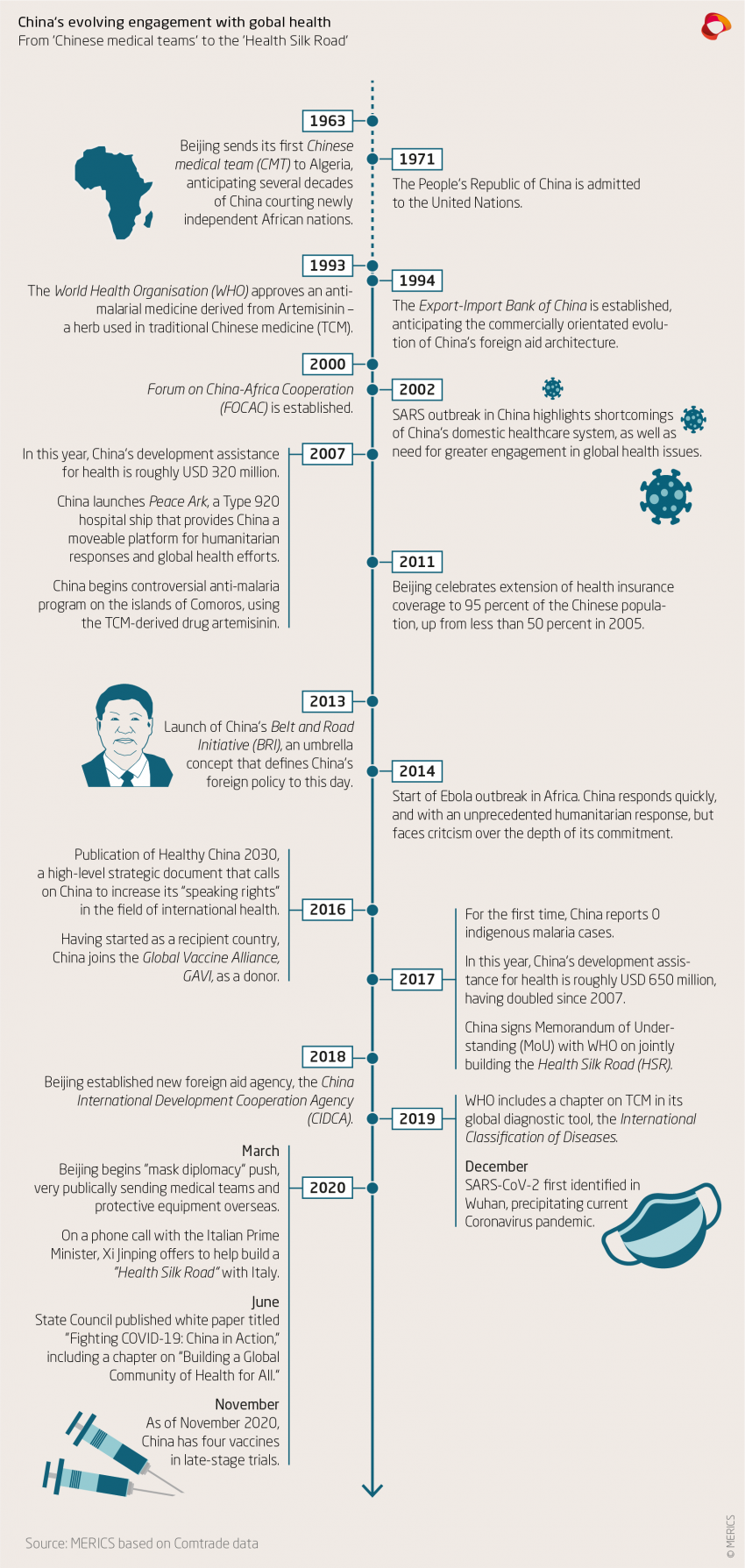

China’s global healthcare ambitions: Gaining influence on the international stage
As part of the Belt & Road Initiative (BRI), Beijing announced the concept of a “Health Silk Road” (HSR) in 2015. Like the BRI itself, the HSR is very much an incarnation of Beijing’s global ambitions, argues Jacob Mardell. This article is the third and final piece in a series on China’s international health politics. See also the first post China’s Vaccine Diplomacy and the previous post on China’s health diplomacy via the BRI.
China’s evolving engagement in global health is not without substance. Beijing wishes to demonstrate its leadership potential in the field and to gain influence commensurate to its perceived weight in the international community. To those ends, its engagement with global health has been on the rise alongside all other indices of Chinese power.
To understand the wider meaning of the Health Silk Road, it is worth beginning with the picture of China’s decades long record of overseas development assistance for health (DAH).
Starting with Algeria in 1963, Beijing dispatched Chinese medical teams (CMTs) throughout the 60s and 70s in order to further political solidarity with newly independent African nations. After 1978, Beijing’s strategic priority became economic reconstruction at home. Its approach to aid shifted accordingly, becoming more experimental and diversified, with commitments re-orientated around China’s economic agenda. CMTs leveraged their presence to introduce Chinese-made medicines, and in 1993, the World Health Organisation (WHO) approved an antimalarial medicine derived from Artemisinin – a herb used in traditional Chinese medicine (TCM).
China’s overseas development assistance for health has grown dramatically
As with everything else in 21st Century China – the tale of Beijing’s DAH in the new millennium is one of dramatic growth. Relative to its population size and government spending, China’s DAH is still modest, but it has more than doubled over the decade since 2007, to USD 652.3 million by 2017. China is still also a recipient of DAH – it received USD 244.5 million in 2016 – but leading other “non-traditional” donors like Brazil and India, it has emerged as a major player in global health.
China is still known for its CMTs, but nowadays the bulk of its development health assistance arrives in medical supplies and the construction of health facilities. Although China differs from other donors in generally eschewing disease specific programs, Beijing has prioritized malaria control in Africa. On the islands of Comoros, Beijing has pursued a successful, if initially controversial plan to eradicate malaria using Artemisinin derived drugs. Following its experience with SARS in 2003, China has also become more invested in health security, and though it faced criticism over the depth of its commitment, it launched a speedy and unprecedented humanitarian response to the Ebola outbreak of 2014-2016.
Beijing holds that the world can learn from its record on tackling health issues
As with much of China’s overseas development assistance, DAH is largely delivered bilaterally and Beijing is slow to cooperate with international partners. At the same time, Beijing has taken a profound interest in increasing its voice on global health issues. It wants a level of recognition commensurate with its economic weight and perceived importance. Beijing firmly believes that China’s infrastructure-based growth provides a model for developing countries. Likewise, it holds that the world can learn from China’s impressive domestic record on tackling health issues like maternal mortality.
Firm evidence of Beijing’s profound interest in the global health agenda is reflected in the three year plan China’s National Health and Family Planning Commission (NHFPC) unveiled in 2015 for the HSR. It includes 38 goals that run the full gamut of engagement, from training schemes to infectious disease prevention and emergency aid.
The plan includes quite specific programs clearly in the public interest, such as those for infectious disease prevention among China’s poorer neighbors in the Mekong region. As with most sector and region-specific documents related to the BRI, the HSR plan also allows the NHFPC to boost the domestic weight of its agenda by packaging its interests within politically correct BRI terminology. Traditional Chinese Medicine (TCM) features prominently in the NHFPC plan, which outlines the ambition to “help traditional Chinese medicine go global.” In every field of human endeavor Beijing seeks to demonstrate leadership potential through the provision of Chinese solutions, and TCM is central to the HSR narrative that the Chinese experience can uniquely contribute to global health.
Beijing’s actual contributions still fall short of fulfilling its ambitions
“Healthy China 2030”, a high-level strategic document published in 2016, contains a section on international exchange that calls on China to increase its “speaking rights” or “discursive authority” (话语权) in the field of international health. The following year, Beijing’s voice did grow louder when it signed a memorandum of understanding (MoU) on jointly building the Health Silk Road with the WHO in 2017. On occasion of the signing, Xi presented the WHO with a bronze acupuncture statue – a potent symbol of Beijing’s soft power aspirations. Later that year, WHO Director General Tedros Adhanom called the HSR a “visionary” proposal, and in 2019 TCM received international validation when WHO included a chapter on the practice in its International Classification of Diseases.
Like the BRI itself, the HSR is less a plan for China’s global health engagement, and more of a brand that amalgamates a great diversity of initiatives in an expression of Beijing’s confidence to act and lead globally. Beijing’s actual contributions to global health and its current capacity fall short of fulfilling these ambitions, but its intentions are clear. For now, and as usual, rhetoric precedes reality, but Beijing’s past record on DAH growth suggest its potential.

